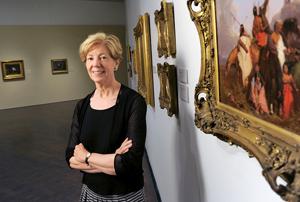For decades, Professor Carol Clark has been hunting for lost works by a gifted painter of the American frontier.
By Emily Gold Boutilier
 Professor Clark at the Denver Art Museum. She assembled the museum’s Charles Deas retrospective, which includes 36 works of art. For 30 years, Clark has been authenticating and locating lost works by Deas. |
Carol Clark was a curator at the Amon Carter Museum of American Art in Fort Worth, Texas, in 1980, when an art dealer showed her a painting. “It was a small and, I thought, extremely beautiful work of art,” says Clark, now the William McCall Vickery 1957 Professor of the History of Art and American Studies.
The painting was Indian Group, by Charles Deas, who in the 1840s was well known for his depictions of the American West. Committed to an insane asylum at the age of 29, Deas (pronounced daze) died at 48, his body of work—some 100 paintings and drawings, all but a few completed before he was 30—forgotten.
The museum bought Indian Group on Clark’s recommendation. Intrigued, Clark set out to locate other works by the artist. Finding only 20, she wondered: where had the rest of them gone?
Clark has spent three decades trying to find out. The results of her sleuthing are on display through Nov. 28, 2010, at the Denver Art Museum, where she has assembled the first retrospective of Deas’ work—36 pieces, many authenticated and located by Clark herself. (Scott Wands ’00 is among the Amherst students who helped with the search.)
 Indian Group, by Charles Deas |
Among the pieces is Long Jakes, the Rocky Mountain Man, which spent decades in a wooden crate in a basement and then under a bed in Minneapolis. In a home in Nova Scotia, Clark identified the 1838 Deas barroom scene Walking the Chalk. She discovered other works hiding in plain sight, including four portraits of Winebagoes in the collection of the St. Louis Mercantile Library, which had received them in 1869 with no indication of the artist’s identity. In 1993, the Mercantile librarian, having read an article by Clark about Deas, invited her to look at the portraits. Clark put them in the Deas column.
Deas’ paintings tell a particular story of the 1840s, “a moment when the fate of the nation was much in doubt,” Clark says. By moving west and sending work to New York, Deas “put a face on a region,” she says.
Clark is still on the hunt for the 50 to 60 works that remain missing, among them A Vision, described in 1849—after Deas had been institutionalized—as “the concentrated essence of a thousand nightmares.”
To accompany the exhibition, Clark wrote the 2009 book Charles Deas and 1840s America (University of Oklahoma Press), which includes an essay by Frederick E. Hoxie ’69.
Top photo by Chris Schneider / New York Times / Redux
Bottom photo courtesy of Denver Art Museum (painting on loan from Amon Carter Museum of American Art, Fort Worth, Texas)
More Deas images from the Denver exhibit are here.